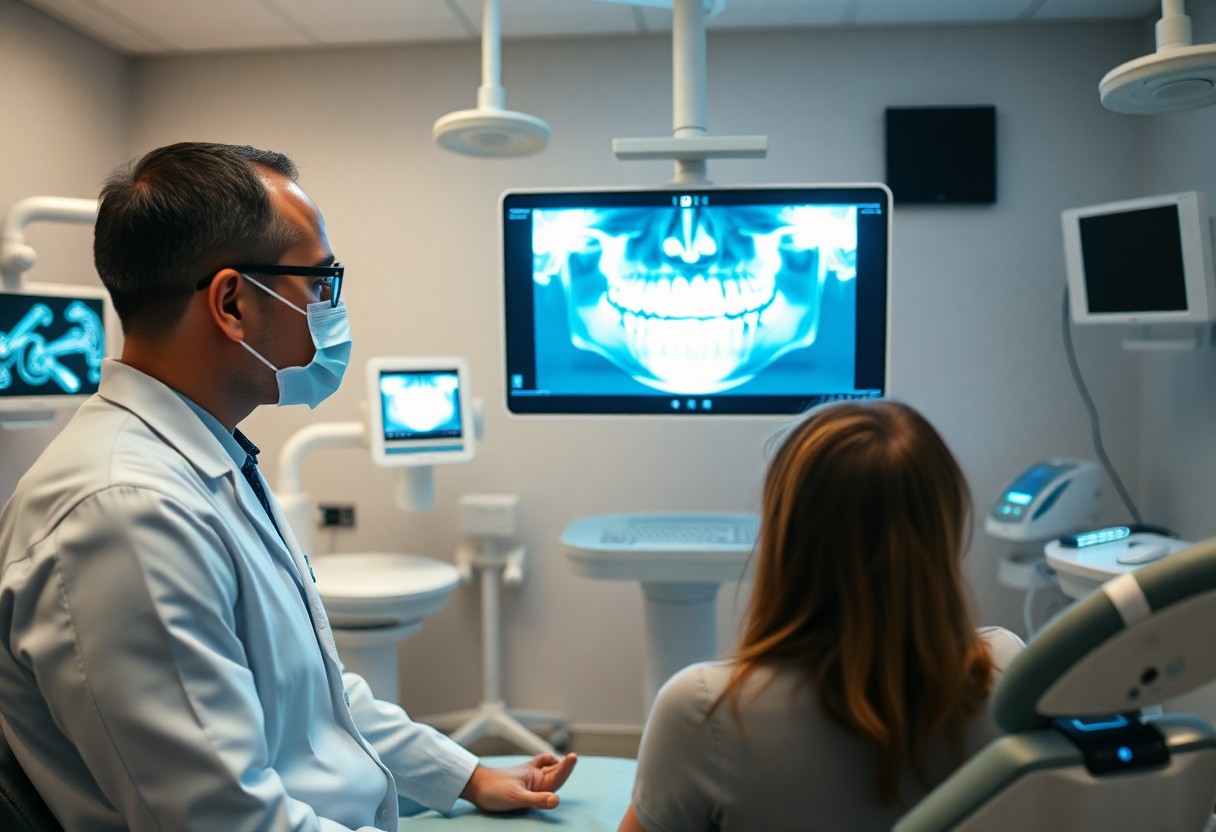Revolutionizing Radiology – The Role Of Dental AI In X-rays And Patient Care
Just when you thought dental care couldn’t get any better, artificial intelligence is stepping in to transform the way X-rays are processed and interpreted. By integrating AI technology into your dental practice, you can enhance diagnostic accuracy, reduce human error, and improve overall patient outcomes. This blog post offers insights into how dental AI is redefining radiology, aiding in faster identification of issues and offering personalized treatment recommendations, thereby streamlining your patient care experience.
Key Takeaways:
- Enhanced Accuracy: Dental AI significantly improves the diagnostic accuracy of X-ray interpretations, reducing the likelihood of missed findings.
- Efficiency: Integration of AI in radiology speeds up image analysis, allowing dentists to provide quicker treatment decisions.
- Patient Care: By leveraging AI insights, healthcare providers can create more personalized treatment plans, enhancing overall patient outcomes.
- Training Support: AI-powered tools serve as effective training aids for dental professionals, improving their skills in interpreting radiographic images.
- Regular Monitoring: Dental AI enables continuous monitoring of patients’ oral health through ongoing analysis of radiographic records, facilitating proactive care.
Understanding Dental AI
To grasp the significance of Dental AI in modern radiology, you must first comprehend its foundational concepts. Dental AI refers to the integration of artificial intelligence technologies within the dental field, particularly in the analysis and interpretation of dental X-rays. This innovative approach enhances diagnostic accuracy and improves patient outcomes while streamlining workflows in dental practices.
Definition and Overview
With advancements in technology, Dental AI has emerged as a game-changer in radiology, enabling dental professionals to analyze X-rays with unparalleled precision. By utilizing machine learning algorithms, these systems can assist in identifying anomalies and facilitating early disease detection, ultimately leading to better patient care.
Key Technologies in AI
Dental AI employs a variety of technologies, including machine learning, deep learning, and computer vision. These tools allow systems to learn from vast datasets, improving their ability to detect and classify dental conditions accurately. Machine learning algorithms analyze historical data, while deep learning models leverage neural networks to identify intricate patterns in images. Additionally, computer vision techniques enable the automation of X-ray interpretation, minimizing human error and enhancing diagnostic capabilities.
Definition plays a pivotal role in understanding the fundamental components of AI technologies. Machine learning algorithms are designed to learn from data inputs, helping to improve efficiency and diagnostic accuracy in your dental practice. With deep learning, neural networks can dissect complex structures within digital X-rays, aiding in identifying potential issues that may not be visible to the human eye. Finally, computer vision streamlines workflows by automating the interpretation of radiographs, allowing you to focus more on patient care while ensuring accuracy and timely diagnoses.

The Role of AI in X-ray Interpretation
There’s a transformative shift occurring in how dental X-rays are interpreted, driven by the integration of AI technologies. You can now leverage these advancements to enhance diagnostic precision and patient outcomes. AI algorithms can analyze images rapidly, identifying abnormalities with unparalleled speed and accuracy, thereby revolutionizing the standards of patient care.
Enhancements in Image Analysis
Role of AI in image analysis is significant. With advanced machine learning techniques, AI systems can sift through vast amounts of radiographic data, detecting patterns that may elude the human eye. This results in more comprehensive and accurate interpretations, ensuring that you provide your patients with the best possible care.
Reducing Errors and Improving Accuracy
About the impact of AI on error reduction is profound. By minimizing the chances of misinterpretation, AI tools enhance the reliability of dental diagnostics, allowing you to catch potential issues before they escalate.
Hence, utilizing AI in X-ray interpretation proves to be a game changer. AI systems can significantly reduce the risk of misdiagnosis that can lead to inadequate treatment plans. With these tools, you can expect higher accuracy in identifying dental conditions, ultimately leading to improved patient outcomes and satisfaction. The integration of AI empowers you to make informed decisions, providing your patients with precise diagnoses and tailored treatment plans.

Patient Care Transformation
All advancements in dental AI are significantly transforming patient care by streamlining diagnostic processes and optimizing treatment outcomes. By incorporating intelligent algorithms and machine learning, practitioners can offer more accurate assessments and tailor procedures to meet individual patient needs. This revolution in radiology not only enhances the quality of care but also increases efficiency, allowing you to enjoy a more personalized dental experience.
Personalized Treatment Plans
Across the dental landscape, AI technology facilitates the development of personalized treatment plans that cater specifically to your dental health needs. By analyzing data from your X-rays and historical records, AI systems can recommend tailored interventions that not only address current issues but also prevent future complications, ensuring a proactive approach to your oral health.
Enhanced Patient Communication and Engagement
Transformation in your dental experience comes with enhanced patient communication and engagement, making consultations much more interactive and informative. With AI-driven tools, you gain access to clear explanations of your diagnoses and treatment options, fostering a collaborative atmosphere between you and your dentist.
In fact, these technologies enable real-time communication, allowing you to ask questions and voice concerns directly related to your care. The use of visual aids and detailed reports generated from AI analysis empowers you to make informed decisions. By providing instant access to your health information, these innovations ensure that you feel valued and engaged in your treatment journey. Enhanced transparency not only builds trust but also encourages you to take an active role in your oral health management.
Challenges and Limitations
Once again, the integration of AI in radiology is not without its hurdles. Challenges such as data privacy concerns, regulatory compliance, and the need for continuous updates can impede the seamless adoption of AI technologies in dental practices. Additionally, variability in the quality of training data and potential biases in algorithms can affect diagnostic accuracy, warranting careful attention to these limitations as you consider the integration of dental AI in your practice.
Ethical Considerations
Limitations regarding ethical considerations surround the use of dental AI in diagnostics. As you navigate this technology, it is imperative to prioritize patient consent and data privacy while ensuring the responsible use of AI-generated insights to maintain trust in your patient relationships.
Technology Integration Issues
At the forefront of adopting dental AI are technology integration issues that can hinder effective implementation.
Integration of AI into existing dental systems can often be challenging due to factors such as compatibility with current software, the need for specialized training for your staff, and financial constraints associated with upgrading infrastructure. You may also encounter resistance from team members who feel threatened by AI technologies, resulting in a lack of enthusiasm for embracing change. To overcome these obstacles, fostering an environment of collaboration and continuous learning is vital, helping you to enhance the patient experience while reaping the benefits of advanced diagnostic capabilities.

Future Trends in Dental AI
Keep an eye on the evolving landscape of dental AI, where advancements will continuously enhance diagnostic capabilities, streamline workflows, and improve patient outcomes. As technology progresses, you can anticipate increasingly sophisticated tools that integrate seamlessly into dental practices, promoting better communication and collaboration between dental professionals and patients.
Innovations on the Horizon
After identifying the need for improved diagnostic tools, researchers and developers are actively working on AI-driven innovations that promise greater accuracy and efficiency in interpreting dental X-rays. Emerging technologies such as deep learning algorithms and machine learning models will enable you to achieve faster diagnoses and more precise treatment plans.
The Future of AI in Dental Practice
For your dental practice, AI holds the potential to transform patient care permanently. By incorporating AI solutions, you can enhance diagnostics, tailor treatment plans, and provide better preventive care, ultimately aiming for superior patient satisfaction. These AI systems will optimize your workflows while reducing the chances of human error, thus ensuring that your practice remains at the forefront of technology.
The integration of AI into your daily dental practice will streamline procedures from patient scheduling to diagnosis and treatment recommendations. Enhanced imaging analyses powered by AI will help you detect issues that might be missed by the human eye, leading to earlier interventions and improved patient outcomes. In addition, AI-driven patient management systems will facilitate personalized care, enhancing the overall patient experience and fostering stronger loyalty. As the technology evolves, you can leverage these tools to maintain a competitive edge and ensure that your practice embraces a future filled with innovation.
Summing up
Ultimately, as you explore the advancements in dental AI and its integration into X-rays, you’ll recognize how these innovations are transforming patient care. By harnessing AI’s capabilities, you can enhance diagnostic accuracy, streamline workflows, and ultimately improve outcomes for your patients. This technology empowers you to elevate your practice, providing a higher standard of care that keeps pace with modern demands and enhances the overall patient experience.
FAQ
Q: What is the role of dental AI in interpreting X-rays?
A: Dental AI utilizes advanced algorithms and machine learning techniques to analyze dental X-rays. It can identify various dental conditions, such as cavities, periodontal disease, and other anomalies, often with high accuracy. By assisting radiologists and dentists, AI can speed up the diagnostic process and help in making informed treatment decisions.
Q: How does dental AI improve patient care?
A: Dental AI enhances patient care by providing more accurate diagnoses and personalized treatment plans. It minimizes human error and allows for quicker turnaround times in X-ray analysis, enabling healthcare professionals to address dental issues more efficiently. This leads to better management of patients’ oral health and potentially improved outcomes.
Q: Can dental AI replace human radiologists in interpreting X-rays?
A: While dental AI can significantly assist in interpreting X-rays, it is not designed to replace human radiologists. Instead, AI acts as an adjunct, providing support by highlighting potential areas of concern for further review. The combination of AI technology and human expertise results in a more effective diagnostic process.
Q: What are the benefits of using AI in dental imaging?
A: The benefits of using AI in dental imaging include enhanced accuracy in detecting dental conditions, reduced diagnostic time, and improved efficiency in workflow. AI can also facilitate standardized evaluations, ensuring consistency in diagnostic practices across different practitioners and institutions.
Q: Are there any concerns regarding the use of AI in dental radiology?
A: Some concerns regarding AI in dental radiology include data privacy, the potential for over-reliance on technology, and the need for continuous validation of AI algorithms. It is important for dental practices to implement AI solutions cautiously, ensuring that they support, rather than undermine, the training and skills of dental professionals.
Q: What technologies are commonly used in dental AI for X-ray analysis?
A: Common technologies used in dental AI for X-ray analysis include convolutional neural networks (CNNs), image recognition algorithms, and deep learning frameworks. These technologies enable the system to learn from vast amounts of data, improving its ability to recognize patterns and anomalies in X-ray images over time.
Q: How can dental practices integrate AI into their workflows?
A: Dental practices can integrate AI into their workflows by adopting AI-driven radiology software that can be easily integrated with existing radiographic systems. Training staff on how to use these tools effectively is key, as is regularly evaluating the AI system’s performance to ensure it meets the specific needs of the practice and its patients.






